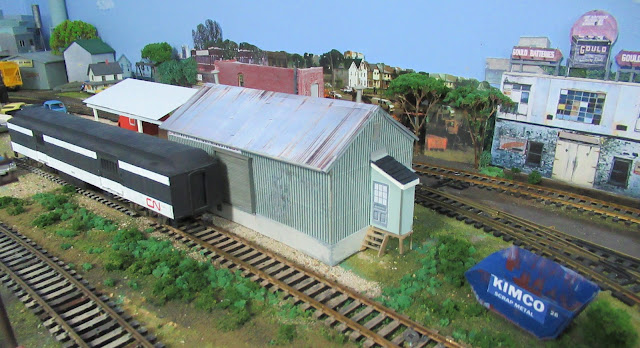In 1965, CN relocated its freight shed from downtown on Wellington Street to the Outer Station property on Montreal Street. The shed was rail-served, with doors and docks for truck loading (yellow arrow, 1978 top photo). I've seen at least one similar shed, built by CN at Morrisburg and still standing. The Kingston shed is now demolished - part of the concrete dock is still visible, but that's all. CN MoW trucks were at the shed decades later:
The building I used has been repurposed over my various layout iterations. Built as an Esso agency, there was a loading dock at the front....
....and a boxcar door on the back. I removed the remnants of the Campbell siding from the roof, adding a new styrene roof, a portion of a Tyco loading dock, and a new rail-served door:
The dock is covered by a heavy steel framework. I've removed the former truck loading dock and I've assembled some leftover pieces from an inexpensive thrift-store town hall kit:
I assembled the framework over the dock. The roof is covered with a paper printed image of rusty corrugated steel. Part of me wanted to leave the framework exposed - so the roof will be removable to show dock operations. I've also added a paper 'concrete foundation' here. Rail-served side:
Truck-loading side:
A word about scale and placement. The prototype shed is well over a hundred feet in length, not counting the dock. My available space is less than that, including the dock! I want to leave room for truck access. Also, the prototype shed's spur approaches from the opposite side of the building. As I've found with my National Grocers building, having the spur on the far side of the building makes the freight cars less visible and less interesting! So, practising selective selectivism, I placed the shed on an existing spur, leaving the cars visible.
Imagine it's a hundred feet long! I added some dock details, shown here with the roof off:
A view of the other end, with shed access and stairs. CN baggage cars were spotted here for extended periods, providing extra storage. Initially, shipments arrived by rail, but in later decades, by transport truck for transfer and delivery by CN Express trucks.
Trackside views (below). Operationally, I'd originally conceived this spur as the Chown Hardware lumber shed (watch for an upcoming post). But I already have two consignees that receive lumber, so I didn't need another place to spot lumber cars. Instead, CN boxcars, baggage boxcars, baggage cars and insulated cars and occasional refrigerator cars. Bringing in cars of express shipments, the cars are often redirected to the downtown freight shed to be loaded and sent off the layout. (Is that weird, sending cars between two sheds when only one was in existence at a time? Hmmm...) The prototype had a large CN-Express-Freight-Kingston-CN sign on it.
All that's currently left of the prototype - the concrete dock being engulfed by vegetation - September, 2019!
Prototype cargo truck box:
And for some time, a track machine donated to the Canadian Institute of Guided Ground Transport (CIGGT) was stored behind the shed with MoW cars - online auction site photo:















No comments:
Post a Comment
I'm happy to hear from you. Got a comment about the Hanley Spur? Please sign your first name so I can respond better.